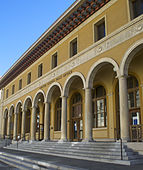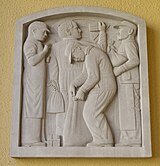United States Post Office (Berkeley, California)
U.S. Post Office | |
Berkeley Landmark No. 38 | |
 | |
| Coordinates | 37°52′8″N 122°16′13″W / 37.86889°N 122.27028°W |
|---|---|
| Built | 1914 |
| Built by | Van Sant-Houghton, Co. |
| NRHP reference No. | 81000144[1] |
| BERKL No. | 38 |
| Significant dates | |
| Added to NRHP | August 14, 1984 |
| Designated BERKL | June 16, 1980 |
The U.S. Post Office, also known as the Berkeley Main Post Office, is a local branch of the United States Postal Service. The building, located at 2000 Allston Way,[note 1] Berkeley, California, was built in 1914–15.[note 2][2] The building has been described as a "free adaptation of Brunelleschi's Foundling Hospital."[3] Designed in the Second Renaissance Revival style, the front of the building features terra cotta arches supported by plain tuscan columns.[4][note 3]
The Post Office is within the Civic Center Historic District, a five block area listed on the National Register of Historic Places.[note 4] The district is a locally significant ensemble of harmoniously planned civic buildings that retains a high degree of integrity since achieving significance in 1950. The post office, along with the "Old" City Hall (1909) in the Beaux-Arts style, is among the earliest and the most decorative of the thirteen buildings in the district.[5]
The architect is unknown but Oscar Wenderoth is listed on the cornerstone as he was director of the Office of the Supervising Architect that designed this and many other federal government buildings. The floor space doubled with the completion of the annex in 1932. A few years later, the Treasury Relief Art Project commissioned a sculpture and a mural for the lobby. Both are well-preserved examples of the styles, subjects and dominant themes of New Deal Art.[2] The post office was designated Berkeley Landmark No. 38 on June 16, 1980, by the Landmarks Preservation Commission[6] and added to the National Register of Historic Places on January 29, 1981.[1]
Proposed sale
[edit]Financial problems fueled by onerous Congressional legislation[7] which introduced an unsustainable debt load without acknowledging revenue dynamics[8] prompted a national sale of underused and often aging real estate owned by the USPS. Dozens of properties had been sold despite protests from local communities.[9] The postal service issued a statement that "sales of historic postal properties have been very modest: 7 in 2012 and 6 in 2013." They identified 1,900 properties that are listed or could be considered for listing on the National Register of Historic Places out of 9,000 properties owned by USPS.[10] In 2014, the USPS Office of Inspector General sought an independent review certain appraisals to ensure that they "were representative of the fair market value."[11]
In 2013, the post office was listed for sale with a possible leaseback of the lobby to continue providing postal service. Opponents staged a 33-day encampment on its steps while the City Council unanimously voted to oppose the sale and unsuccessfully sought a one-year delay.[12]
In November, 2014, postal officials announced a tentative sales agreement to a local developer.[13] First They Came for the Homeless immediately established a 2nd occupation on the exterior grounds, the City of Berkeley filed a lawsuit against the sale, the seller withdrew, and in April 2015 federal district judge William Alsup dismissed the case on the basis of the Postal Service's declaration that no sale was pending. The 2nd occupation lasted until April, 12th, 2016 at which time Postal Police cleared the protest.[14]
-
Exterior of the Post Office
-
Mural, Incidents in California History (1937) by Suzanne Scheuer and wood work surrounding the elevator.
-
Sculpture on east side of main entrance. Signed: David Slivka, 1937
Description
[edit]The Berkeley Post Office is located just one block west of Shattuck Avenue, occupying the western half of the block bordered by Allston Way, Harold Way, Kittredge Street, and Milvia Street. The main entrance is on Allston Way, with nearby landmarks including the YMCA, a city office building (formerly Farm Credit), and Berkeley High School. The front part of the building, which includes the customer lobby, offices, and part of the work area, measures 130 feet in frontage by 62 feet in depth and stands 34 feet high. This section has two stories and a basement, featuring a hipped red tile roof. The work area extends 162 feet south along Milvia Street in a one-story building with a basement, matching the front section in design. The northernmost 35 feet of this section are original, with a seamlessly matched extension added in 1931-32. The building is made of reinforced concrete.
The exterior features Bedford limestone up to the water table line, with granite steps. Above this, the walls are covered in cement stucco with terra cotta trimmings in a sanded-cream finish, a first on the Pacific Coast. The main entrance loggia is supported by Kasota marble columns, originally dark in color but now matching the sand-colored terra cotta. The architectural style is typical of 1910s post offices and has been described as an adaptation of Brunelleschi's Foundling Hospital. The Allston Way facade features an arcade of 11 high round arches on plain Tuscan columns, extending along the main floor and forming a loggia about 10 feet deep. The arches are outlined in terra cotta, and a wide terra cotta belt course with classical motifs runs below the second-story windows and around the building, serving as the cornice for the rear section. A smaller terracotta frieze with classical motifs tops the second story just below the eaves. The ends of the facade and side walls are heavily rusticated with cast blocks that simulate stone. Each rusticated section is topped with a terra cotta shield, and the building's corners are rounded and slightly recessed. The hipped roof is covered in red tile over wood sheathing, with a wide overhang featuring two rows of curved wooden brackets framing rectangular panels. In 1979, the cornice soffit was painted in brown, blue, orange, and sand colors during a restoration project that also cleaned and repainted the exterior in shades of beige, yellow, and sand to highlight its details.
The building stands on a partly raised basement, with windows on the west side where the ground level is lower. The cornerstone, located at the north end of the west side, reads: "William G. McAdoo, Secretary of the Treasury; Oscar Wenderoth, Supervising Architect, 1914." A flagpole is situated at the northeast corner. Granite steps lead up from the sidewalk to the middle five arches of the loggia, with seven steps at the east end and ten at the west. The basement has two small windows with metal grilles at each end of the steps. The end arches feature intricate wrought iron railings with heraldic shields and diagonal rope patterns. The loggia has a gray marble floor and baseboards. The inner wall, forming the front wall of the lobby, mirrors the 11 arches and plain capitals of the outer arcade, with the end walls also arched, creating a cross-vaulted ceiling. On the east end wall is a relief sculpture of postal workers by David Slivka, dated December 1937, with the inscription "From U.S., To All Mankind, Truth Abode, On Freedom Road." The fourth, sixth, and eighth arches have paired oak and glass doors with brass fittings, featuring modified Corinthian capitals that are repeated inside the building. The other arches have low cement window sills with wave decorations and double-hung windows with panes grouped in five vertical divisions. All arches are fully glazed with functioning transoms.[2]
See also
[edit]- List of United States post offices
- List of United States post office murals
- List of New Deal sculpture
Notes
[edit]- ^ Nomination form and other sources show address as 2000 Milvia Street.
- ^ Contract was let in April 1914. Postal workers occupied building in September 1915.
- ^ Second Renaissance Revival is often used to describe details common to 1910s post offices all over the country.
- ^ Berkeley Historic Civic Center District listed December 3, 1998.
References
[edit]- ^ a b "National Register Information System". National Register of Historic Places. National Park Service. July 9, 2010.
- ^ a b c "National Register of Historic Places Inventory - Nomination Form: Berkeley Main Post Office". National Park Service. Retrieved 11 December 2013.
 This article incorporates text from this source, which is in the public domain.
This article incorporates text from this source, which is in the public domain.
- ^ "The Berkeley Post Office - an Example of the New Public Building Policy" Architect and Engineer, San Francisco, CA. October 1915, quoted in "National Register of Historic Places Inventory - Nomination Form"
- ^ "UNITED STATES POST OFFICE" Berkeley Historical Plaque Project Accessed 11 December 2013
- ^ "National Register of Historic Places Inventory - Nomination Form: Berkeley Historic Civic Center District # 98000963". National Park Service. Retrieved December 11, 2013.
- ^ "Berkeley Landmarks" Berkeley Architectural Heritage Association Accessed 13 December 2013
- ^ "Postal Accountability and Enhancement Act (2006 - H.R. 6407)".
- ^ "Postmaster General testifies on Postal Reform Act of 2017".
- ^ Romney, Lee (December 7, 2013) "Berkeley making the rounds to save its historic post office" Los Angeles Times
- ^ Romney, Lee (April 18, 2014) "Historic preservation agency seeks halt in post office sales" Los Angeles Times
- ^ Romney, Lee (February 20, 2014) "Inspector general questions Postal Service property sales, leases" Los Angeles Times
- ^ Lee, Seung Y. (February 24, 2015). "Berkeley Preservationists Continue Legal Battle Over Main Post Office". Berkeleyside via KQED News. Retrieved 4 March 2015.
- ^ Taylor, Tracey (November 5, 2014). "Exclusive: Local developer Hudson McDonald in contract to buy downtown Berkeley Post Office". Berkeleyside. Retrieved 4 February 2018.
- ^ DINZEO, MARIA (January 12, 2018). "Trial Unlikely in Fight Over Berkeley Post Office". Courthouse News. Retrieved 4 February 2018.
External links
[edit]- Buildings and structures in Berkeley, California
- Government buildings completed in 1914
- National Register of Historic Places in Berkeley, California
- Post office buildings on the National Register of Historic Places in California
- Renaissance Revival architecture in California
- Treasury Relief Art Project
- 1914 establishments in California
- Berkeley Landmarks in Berkeley, California






